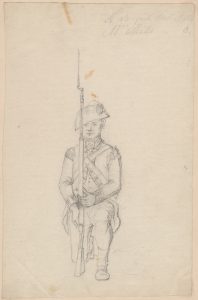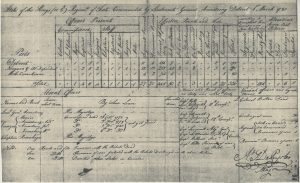Ongoing historical research and archaeological excavations form the backbone of Mackinac State Historic Parks’ interpretive programs and exhibits. This summer, programs at Colonial Michilimackinac will focus on the year 1781 and the fort community at that time. While researching the experience of British soldiers at the fort, we came across a historical mystery! Two hundred and forty-three years ago, in March 1781, five soldiers from Michilimackinac switched sides from the British to join the “rebel,” or, as we would call them today, American, forces. Why and how did this happen?




Historians know where different groups of soldiers within the 8th Regiment were stationed, and even their condition – “present fit for duty,” “sick in quarters,” or even prisoner of war – from records called military returns. Commanding officers of the 8th Regiment, such as Major Arent DePeyster, compiled these documents and sent them to higher officials. It is in one of these documents that we discovered our mystery. In March 1781, DePeyster issued a return that announced the loss of seven 8th Regiment soldiers who were listed as prisoners of war. One soldier had died while prisoner; the other six had switched sides and “inlisted with the Rebels.” Five of the six were from Michilimackinac. This notable detail leads to many questions. Who were these soldiers? How were they captured? Why did they change sides?


We can start to unravel this mystery with the help of some background knowledge. In 1778, Lieutenant Governor Henry Hamilton of Detroit led a group of British, French-Canadian, and Native American forces to modern-day Indiana to confront rebel forces intent on controlling Fort Sackville. The British soldiers in his party were 8th Regiment soldiers from Detroit. After a short battle, Hamilton and his forces were captured by Colonel George Rogers Clark. Some soldiers from the 8th Regiment may have been taken to Virginia for their captivity while others remained as prisoners of war in Indiana; ultimately their full journeys are currently unknown.
Though the 8th Regiment soldiers captured with Hamilton came from the garrison at Detroit, his journal mentioned a grenadier within the group. This means it is possible that some soldiers could have come from Michilimackinac, too. The five Michilimackinac prisoners of war could have been five grenadiers taken with the rest of Hamilton’s expedition.
And now we reach the big question: why would these British soldiers join with the “rebels” in the war? By 1781, the five Michilimackinac soldiers could have been living as prisoners of war for almost two years in unknown conditions. During the American Revolution, prisoners of war on both sides received harsh treatment which could cause poor health or even death in the worst circumstances. Like other prisoners of war, it is possible that the Michilimackinac soldiers made their choice to change allegiances for the sake of self-preservation.


There are still many unknown details in this historical mystery. While facts and probability currently favor that the five prisoners of war from Michilimackinac who joined the “rebels” were grenadiers from Hamilton’s campaign, further research may suggest other theories. Interested in learning more about British soldiers stationed on the Great Lakes? Visit Colonial Michilimackinac this season for programs, demonstrations, and exhibits about these historical figures and others who lived and worked at the Straits of Mackinac.








